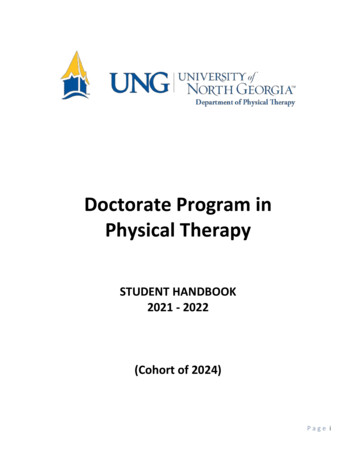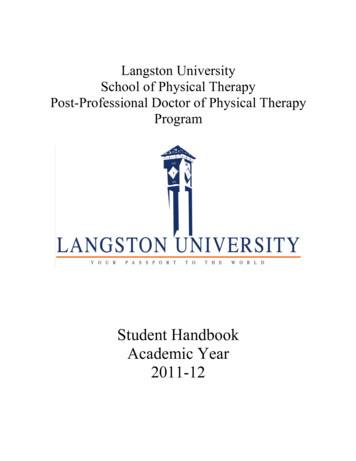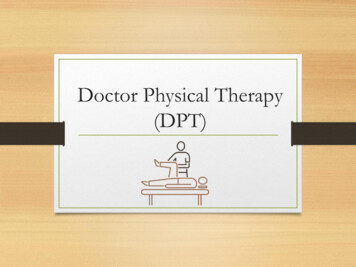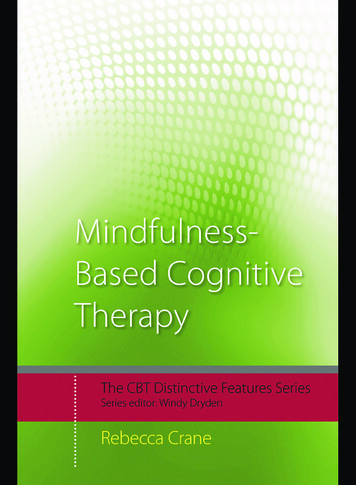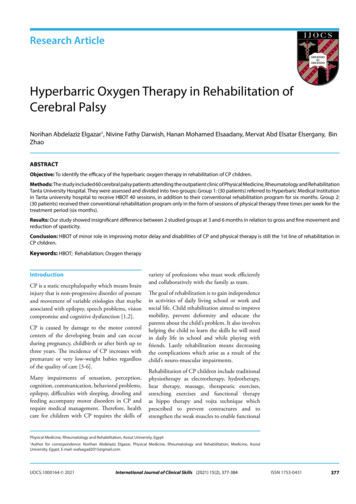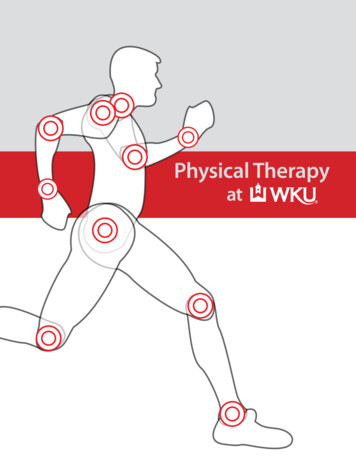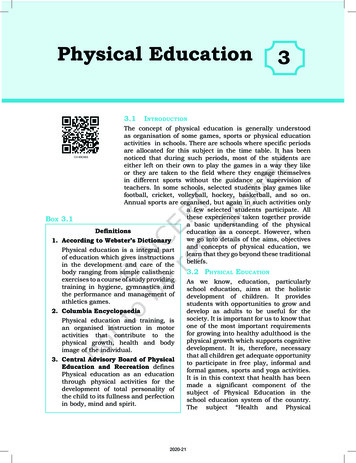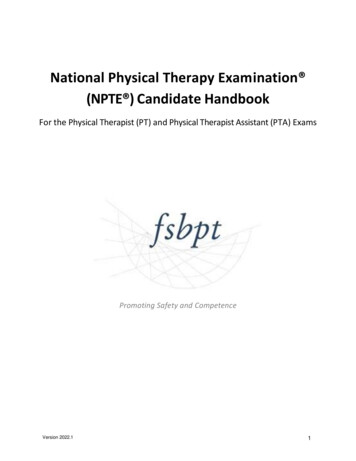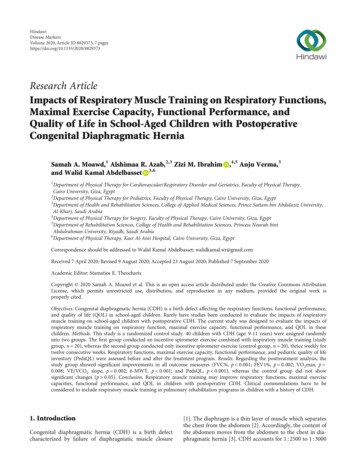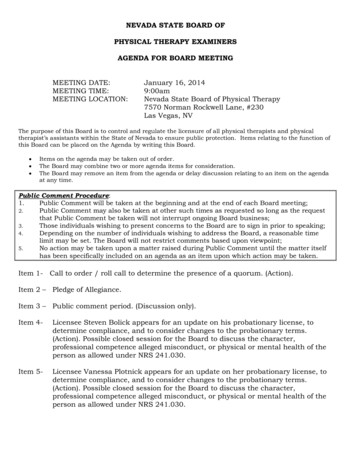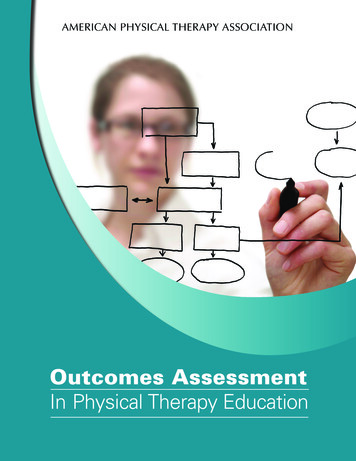
Transcription
AMERICAN PHYSICAL THERAPY ASSOCIATIONOutcomes AssessmentIn Physical Therapy EducationOutcomes Assessment in Physical Therapy Education1
2American Physical Therapy Association
Table of ContentsPagePurpose. 1Chapter One: Introduction and Background. 3Introduction and Background. 3Purpose of Outcomes Assessment. 4Suggested Outcomes Assessment Process for Physical Therapy Education. 5Chapter Two: The Assessment Team and Setting Program Goals. 7The Assessment Team. 7Overview of Terminology. 7What Are Program Goals?. 7Writing Program Goals. 9Selecting Relevant Program Goals. 9Linking Program Goals to Expected Program Outcomes. 9Summary.10Chapter Three: Developing and Implementing an Assessment Plan. 11List Program Goals and Expected Program Outcomes that will be assessed. (Table 1a).12Determine the indicators that reflect the Program Goals and Expected Program Outcomes.(Table 1b).13Identify data needed to reflect the indicators and how these data will be obtained.(Table 1c).14Determine from whom (which individuals or groups of people) identified data will be collected.(Table 1d).15Determine who will collect data. (Table 1e).16Determine who will analyze and interpret indicator data. (Table 1f ).17Determine timeframe(s) for collecting, analyzing, and reporting data. (Table 1g).18Identify target and/or threshold criteria that will trigger the need for change. (Table1h).19Highlight those indicators where there is a mismatch of measure withidentified target and/or threshold criteria. (Table 1i).20Summary.20Chapter Four: Analysis of Results for the Outcomes Assessment Plan. 21Making Sense of Collected Data (Table 2, Column I).21Formulation of Hypotheses (Table 2, Column J).22Change Based on Data-Driven Hypotheses.23Determine specific action(s) needed based on the data-driven hypotheses. (Table 3a).25Identify who/which group(s) will take specific action(s). (Table 3b).25Establish a timeframe for implementation of the specific action(s). (Table 3c).26Summary.27Chapter Five: Closing the Loop. 29Who checks implementation of specific action(s)? (Table 3d).30Establish a timeframe for checking the specific action(s). (Table 3e).31Determine how to evaluate the effectiveness of specific action(s). (Table 3f ).32Institutionalize, revise, or discard specific action (Table 3g).33Communicate with appropriate stakeholders. (Table 3h).34Document specific action(s). (Table 3i).35Feedback Into the Outcomes Assessment Process.36Summary.36Final Summary. 36Glossary. 37Appendixes. 42Resources. 57Outcomes Assessment in Physical Therapy Educationi
2American Physical Therapy Association
Purpose of the Outcomes Assessment InPhysical Therapy Education ResourceThis document presents the various perspectives on and levels of outcomes assessment as they are present in physicaltherapist and physical therapist assistant education programs. It also describes how the various elements of assessmentmight fit together. The information located in this document provides physical therapy education programs, faculty, andresearchers with a systematic structure for use in assessing program and graduate outcomes. Please note that use of thisdocument—Outcomes Assessment in Physical Therapy Education—is voluntary. The Commission on Accreditation inPhysical Therapy Education (CAPTE) does not and will not require use of this guide as part of the accreditation process.The systematic structure provided in the Outcomes Assessment in Physical Therapy Education is a cyclic method for gathering and reviewing data and student learning and development outcomes.Outcomes Assessment in Physical Therapy Education1
2American Physical Therapy Association
Chapter One: Introduction and BackgroundThis chapter presents an overview of student learning and development outcomes assessment, as well as specific applications of outcomes assessment for physical therapist and physical therapist assistant education. It also provides physicaltherapy education stakeholders with a process to assess outcomes to promote student learning and for continuous programimprovement.BackgroundIn 2005, to better prepare students for the 21st century workforce, the United States Secretary of Education formed theSecretary of Education’s Commission on the Future of Higher Education (Commission). In November 2006, the Commission began to explore strategies for streamlining and improving the higher education accreditation process to supportinnovation, promote consistency in accreditation standards, and to increase accountability and transparency to the public.Efforts by CAPTE in the area of outcomes assessment presaged efforts in higher education overall. Since the early 1990s,CAPTE and the American Physical Therapy Association (APTA) have been discussing the development and assessment ofeducation program and graduate outcomes. In 2002 and 2006 respectively, CAPTE revised its documents, Evaluative Criteria for Accreditation of Education Programs for the Preparation of Physical Therapist Assistants and Evaluative Criteria forAccreditation of Education Programs for the Preparation of Physical Therapists, expanding the requirements that programsprovide evidence on how they assess program and graduate outcomes. Assessment is an ongoing aspect of the educationalenvironment. Within the 10-year accreditation cycle for CAPTE there is an opportunity for every physical therapy education program to develop, renew, and revisit its assessment plan.CAPTE provides professional accreditation criteria, and APTA developed A Normative Model of Physical TherapistProfessional Education: Version 2004 by a consensus process (first published in 1997 and revised in 2000 and 2004) andA Normative Model of Physical Therapist Assistant Education (first published in 1999 and revised in 2007). These documents address key issues confronting physical therapist professional education and physical therapist assistant education,including the need for physical therapy education programs to perform outcomes assessment to meet the expectations ofthe CAPTE criteria. Outcomes assessment requirements and practices vary among institutions; therefore, it is assumedthat the regional accreditation processes address the broader perspective of postsecondary education, and that any physicaltherapy education program functions within an accredited postsecondary institution.In March 2005, APTA’s Board of Directors charged APTA staff with producing an Education Strategic Plan to identifyand address the Vision 2020 goals related to education. The outcomes initiative was targeted by APTA’s education stakeholders to be included in Goal 11 of the Education Strategic Plan:Develop leaders in physical therapy academic and clinical education and research with established roles and influences inprominent national and international agencies.Outcomes Assessment in Physical Therapy Education3
Contained within this goal is the specific objective:Develop an educational outcomes assessment model in response to accountability demands for higher education programs.Numerous other goals in the Education Strategic Plan are associated with outcomes assessment (Goals 1-4, 7, 8, 15-17).Therefore, APTA created the Consulting Group on Uniform Outcomes Assessment (CGUOA). This group was responsible for defining outcomes assessment, articulating a purpose for outcomes assessment, identifying individuals who shouldbe involved in the outcomes assessment process, and suggesting a framework for conducting outcomes assessment for useby physical therapy education programs.The CGUOA initially met at the APTA offices in Alexandria, Virginia, on March 23 and 24, 2007. All six working groupmembers attended: Bill Andrews, PT, MS, NCS (Elon University), Cathy Bieber Parrott, PT, MS (Youngstown StateUniversity), Lorna Hayward, PT, EdD, MPH (Northeastern University), Diane Jette, PT, DSc (University of Vermont),Leslie Portney, PT, DPT, PhD, FAPTA (MGH Institute of Health Professions), and Steve Tippett, PT, PhD, SCS, ATC(Bradley University). Several members of the APTA staff were present: Janet Bezner, PT, PhD, senior vice president forthe Education Division; Jody Gandy, PT, DPT, PhD, director of physical therapy education; Mary Jane Harris, PT, MS,director of accreditation; Marc Goldstein, EdD, director of research services; and Ellen Price, PT, MEd, associate directorin the Department of Accreditation. Janet Bezner and Karen Paulson, senior associate at the National Center for HigherEducation Management Systems (NCHEMS), facilitated the meeting.The CGUOA convened a second time on October 25 and 26, 2007. This meeting, also attended by Ken Harwood, PT, PhD,CIE, the new vice president of practice and education, resulted in a draft of this document that framed the purpose, components, and suggested processes for outcomes assessment in physical therapy education. The CGUOA acknowledges thework of the Commission on Accreditation for Dietetics Education and the American Dietetic Association (Outcomes Assessment for Dietetics Educators, 2002) and the American Association of Colleges of Pharmacy (A Guide for Doctor of PharmacyProgram Assessment, 2000), whose outcomes assessment documents influenced the development of Outcomes Assessment inPhysical Therapy Education. (A complete list of references that informed the development process is included at the end ofthe document.)Purpose of Outcomes AssessmentOutcomes assessment is defined as “the systematic collection, review, and use of information about educational programsthat is undertaken for the purpose of improving student learning and development” (Palomba & Banta, 1999). A key goalof assessment efforts is determining whether a program is contributing to student growth and development. The emphasisof outcomes assessment is on the greater good of the program, rather than the performance of an individual student. Thefollowing statements serve as guidelines for outcomes assessment (modified from Palomba & Banta, 1999, p 21): The fundamental purpose of outcomes assessment is improvement of the education program. Assessment of student learning and development is a collaborative process. Assessment is aligned with the institutional mission. Assessment is not used for faculty evaluation. Assessment is an ongoing process. Assessment as a process is continually evaluated. Assessment is related to the curriculum, and the faculty “own” the curriculum.Outcomes assessment encompasses three primary areas: student/graduate, faculty (as it relates to student learning anddevelopment), and program. A culture of outcomes assessment includes faculty and uses a team approach. Focus on outcomes assessment should be sustained over time. Meetings and work are public, driven by a common purpose and a sharedvision related to the larger issues of teaching and learning. Perhaps most important, in a culture of outcomes assessment,there is shared ownership and agreement that assessment results will be used to implement necessary changes.Goals are assessed by a process of establishing expected program outcomes and defining indicators, targets, and thresholds.The outcomes assessment process involves stakeholders consisting of faculty, administrators, professional staff, students,alumni, employers, and community members. It uses authentic and available artifacts to regularly analyze current progressand integrate that information back into the ongoing outcomes assessment process.4American Physical Therapy Association
Suggested Outcomes Assessment Process for Physical Therapy EducationThe model of outcomes assessment presented here for physical therapy education programs parallels Donabedian’s (2003)quality assurance framework in health care (Appendix A). The model adopted by CGUOA employs a five-step cyclicalprocess for outcomes assessment in physical therapy education programs. Although it makes the process of assessmentexplicit and manageable, is not prescriptive. The five steps include: (1) setting goals, (2) developing an assessment plan, (3)implementing the developed assessment plan, (4) analyzing results of assessment, and (5) closing the loop (Figure 1).Figure 1. Model for outcomes assessment in physical therapy education programs.1. Set programgoalsIf assessmentresults notcongruent,make changesand repeatcycle5. Close theloop/feedback2. Develop anassessmentplan4. Analyze results ofassessmentIf assessmentresultscongruent/successful,close the loop3. Implement the developedassessment planSummaryThis chapter has provided a historical perspective of the APTA’s efforts in the development of education program outcomes assessment. A suggested structured process for outcomes assessment in physical therapy education programs hasbeen outlined. The remainder of Outcomes Assessment in Physical Therapy Education is organized into five chapters thatdetail each step in the model: goal setting, planning, implementation, analysis, and feedback.Outcomes Assessment in Physical Therapy Education5
6American Physical Therapy Association
Chapter Two:The Assessment Team and Setting Program GoalsFollowing the framework provided in Chapter One, in this chapter, we define the terminology used in this document.Program Goals are identified and a process for development and selection of goals offered. The chapter will end with asection on linking Program Goals to Expected Program Outcomes.The Assessment TeamBefore beginning, an essential step is to decide who or what group will be involved in outcomes assessment for the physical therapy education program. Clearly, all faculty and administrators ultimately will be involved, but decisions must bemade regarding who will lead assessment efforts and who has ultimate responsibility to ensure that outcomes assessmentis performed. In addition, there should be authority for following through on decisions made. In many cases, programsdesignate an Assessment Team of faculty and staff members, who report and have authority through the dean of academicaffairs. Several roles may exist on an Assessment Team: faculty (assistant, associate, and full professor), academic advisors,career counselors and others from student services, and administrators.Overview of TerminologyTo maximize understanding of the information that follows, a common language was adopted for use in OutcomesAssessment in Physical Therapy Education. Based on CGUOA discussions, the following language was agreed upon forthe various components of outcomes assessment described in this document. The components are meant to be hierarchical, such that, starting at the lowest level, the target and threshold relate to a specific indicator, which relates to a specificExpected Outcome, which relates to a specific Program Goal.Overarching Program Goals (Chapter 2)Expected Outcomes for Program, Faculty, and Graduates/Students (Chapter 2)Indicators (Chapter 3)Targets and/or Thresholds (Chapter 3)What Are Program Goals?The first step in outcomes assessment is writing overarching Program Goals. This section will address what goals are, howto write Program Goals, how to select relevant Program Goals, and how Expected Outcomes are developed to assessgoal achievement. Huba and Freed (2000) envision the relationship of learning outcomes for an institution, a particularacademic program, courses that comprise that program, units within courses, and finally lessons with units (Figure 2).Although specific to learning outcomes, this illustration helps frame how the outcomes or Program Goals of an academicprogram—the physical therapy education program—are related to academic structures both broader than and includedwithin the program.Outcomes Assessment in Physical Therapy Education7
Figure 2. Plan for designing and delivery learning outcomes (Huba and Freed, 2000).From May E. Huba & Jann E. Freed Learner-centered Assessment On College Campuses: Shiftingthe Focus From Teaching to Learning, 1/e. Published by Allyn and Bacon/Merrill Education, Boston, MA Copyright 2000 by Pearson Education. Reprinted by permission of the publisher.Overarching Program Goals are broad statements that reflect the desired results that physical therapy education programfaculty and students strive to achieve. Goals are realistic and achievable statements expressing what the program mustachieve to accomplish its mission (CAPTE). As such, Program Goals should be grounded in both the program’s and institution’s mission and values to ensure that assessment becomes the process of improving what key stakeholders (primarilyfaculty and administrators) have decided is important for the institution and program (AAHE, n.d.). This descriptionof Program Goals is consistent with CAPTE’s 2006 Evaluative Criteria for Accreditation of Education Programs for thePreparation of Physical Therapists (“P-2. The program has goals that are based on its stated mission”) and with CAPTE’s2002 Evaluative Criteria for Accreditation of Education Programs for the Preparation of Physical Therapist Assistants (“1.2.2.The goals and objectives of the physical therapist assistant program support the program’s mission and philosophy and areconsistent with the mission and philosophy of the institution”). A program’s mission is a statement of beliefs that guidesplanning and operation, describes why the entity exists, and includes the unique features of the entity (Haessig & Potin,2002, p. 10).Aligning a physical therapy education program’s mission and goals with the institutional mission frames outcomes assessment within the context of what the institution values. This linkage fosters institutional support for outcomes assessmentand any resulting quality improvement in physical therapy education programs. This association is illustrated in the nextsection and throughout Outcomes Assessment in Physical Therapy Education. (Haessig & Potin, 2002, p. 7). To facilitatethis process, the broader overarching Program Goal statements should be expressed in quantifiable and assessable outcomemeasures.8American Physical Therapy Association
Writing Program GoalsBasing Program Goals on the program and institutional mission statements ensures that goals are relevant and meaningful.It is considered good practice for goals to reflect outcomes that encompass all physical therapy education program activities, which can usually be divided into three categories: student/graduate, faculty, and program. The following sectionprovides a guide to writing Program Goals. Gather and review the following:Program and institutional mission statements and gioals, Professional documents that describe expected skills and abilities of the graduate (Evaluative Criteria,Normative Model, National Physical Therapy Examination blueprint, minimal skills documents,Professionalism Core Values). Previous assessment data, where applicable.Brainstorm about what the physical therapy education program wants to accomplish. Brainstorming is typically done with all core faculty or a subgroup of the core faculty, as well as with anyother individuals the program wishes to include. The identification of what the program wants to accomplish should reflect not just the curricular goals, butalso the goals of the program and faculty.Draft broad statements describing what the physical therapy education program wants to accomplish.(When the cycle restarts again, these broad statements may indicate a new focus or initiative for the program.)Refine the broad statements into realistic, achievable, and measurable Program Goals.Obtain approvals as appropriate for your institution. Refer to Appendix B for examples of Program Goals.Selecting Relevant Program GoalsAt this point, the Assessment Team should have a list of potential overarching Program Goals, from which it will select thosethat most directly reflect, at that time, what is most important for the physical therapy education program to achieve and assess. Selecting a manageable number of Program Goals for the assessment process will enhance the physical therapy educationprogram’s ability to complete the assessment process in a timely and useful manner. To maximize manageability, select no morethan three to five Program Goals for assessment and no more than three to five Expected Program Outcomes.The following guidelines may be useful in identifying overarching Program Goals on which to focus in theAssessment Plan. Goals should link to the institution’s strategic plan and reflect how the physical therapist education program fitswithin the context of the institution’s mission, ie, core curriculum. Consider identifying Program Goals that focus on program improvement. Determine if any institutional or accrediting agency mandates must be included. Look for opportunities to group goals together as broader statements. Consider the needs of external stakeholders (eg, clinicians, health care system).Linking Program Goals to Expected Program OutcomesThe next step in outcomes assessment is to write Expected Program Outcomes based on Program Goals. As defined byCAPTE, Expected Program Outcomes are predictable and demonstrable results of program, faculty, and student activities directed toward achievement of the stated Program Goals. Outcomes make goals quantifiable and assessable (Haessig& Potin, 2002, p. 7). Expected Program Outcomes can be categorized as student/graduate, faculty, or program outcomes.Expected Program Outcomes may also relate to more than one goal (see Appendix B for examples).Outcomes Assessment in Physical Therapy Education9
Some suggestions on how to write Expected Program Outcome statements include: For Expected Program Outcomes reflecting student/graduate outcomes, it may be helpful to begin with the phrase:“Upon completion of the program, students/graduates will be .” Refrain from writing student/graduate programoutcome statements that reflect what the instruction will be or what faculty will do. (Walvoord, 2004, p. 53) Faculty Expected Program Outcomes may begin with the following phrase: “Faculty of the physical therapy education program will .” Program-level Expected Program Outcomes may begin with the following phrase: “The physical therapy education program will .”An example of a Program Goal that will be used throughout this document is: “Graduates will demonstrate the skillsnecessary for the entry-level practice of physical therapy.” An Expected Program Outcome that comes from this ProgramGoal is: “Students/graduates will communicate with various constituents in a manner that reflects their level of knowledge, considers health literacy, is sensitive to cultural issues, and demonstrates respect.”SummaryThis chapter has focused on developing strong Program Goals and Expected Program Outcomes that illustrate a stronglink between the program and university mission and outcomes. It has also provided a foundation for and will facilitatethe building and implementation of an equally strong Assessment Plan by physical therapy education programs.10American Physical Therapy Association
Chapter Three:Developing and Implementing an Assessment Plan(Adapted from the work of the American Dietetic Association, Haessig & Potin, 2002)In the previous chapter, the physical therapy education program articulated its Program Goals and determined the Expected Program Outcomes related to those goals. Program Goals are linked to the institutional vision, mission, and goals,as well as to the vision and mission of a physical therapy education program. Well-developed goal and outcome statementsprovide the basis that the physical therapy education program will use to assess the extent to which it is meeting the program’s mission. Program assessment uses a variety of methods, employed by individuals representing diverse constituentsor stakeholders, and has a sustained focus. The following example outlines the components of an Assessment Plan, as wellas ways in which these components can be operationalized.Table 1 presents a generic template illustrating the suggested outcomes assessment process described in this document. Wewill build on the template as we discuss each component of the Assessment Plan. The various components of the Assessment Plan summarized in this chapter are: List Program Goals and Expected Program Outcomes that will be assessed. Determine the indicators (actions or behaviors) that reflect the Program Goals and Expected Program Outcomes. Identify dat
The fundamental purpose of outcomes assessment is improvement of the education program. Assessment of student learning and development is a collaborative process. Assessment is aligned with the institutional mission. Assessment is not used for faculty evaluation. Assessment is an ongoing process.


